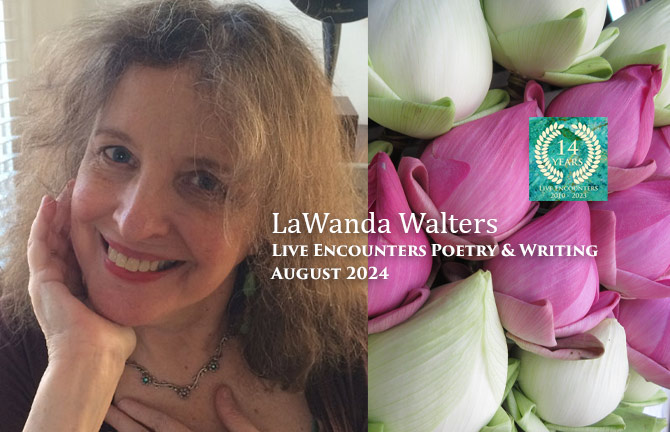
Live Encounters Poetry & Writing August 2024
Three Ekphrastic Poems by LaWanda Walters.
Into the World There Came a Soul Called Ida
But the peanut shells must have made him mad.
And my rejection. And he didn’t want to let me go.
So he kept adding things on—cellulite and varicose
veins and a cigarette with smoke rising
from a cut-glass ashtray. He had this brush
with only three hairs, from a boar
or some other animal. He loved detail,
and details are what we get when we age.
So he made me fifty and fat and like
I’d been a prostitute. But it was only me,
sitting for him at nineteen and twenty
and sometimes my beautiful baby girl
would be in the basket on the floor.
That’s the true story, which you’ll think
is more boring than you’d hoped.
I never did smoke or drink, myself,
and if I thought that fifty looked old—why,
I lived to be in my nineties.
I never did get those veins, and I had
better metabolism than he’d planned on.
I stayed thin and never had that overhang
of cleavage like the lady in the painting.
But that peanut shell on the floor—
that shell is the truth, painted so exactly right
with his miniature, three-haired brush
that it makes me blush now.
How rude of me to throw them there
like I was sitting in a movie theatre.
Student, 1968, by Wayne Thiebaud
I was that student in 1968,
although my hips were wider.
But I sat like that in Victorian Lit,
unaware of how I’d like it, later,
Victorian literature. The student
in this work keeps her narrowed eyes open
while, in that class in Charlotte, I couldn’t.
This California girl looks a little sullen.
She’s blonde, her straight hair parted neatly.
She stares like she knows she’s on display,
her feet apart in blue tennis shoes,
faded jeans tight on her thighs
in the valley’s light. Her lap becomes
a canvas—between her legs, a shadow
might be a golf tee, even a slit. A rainbow
is glancing off her collarbone.
I was bored. The professor was bald,
and his talk on Matthew Arnold wasn’t
thrilling. I could not believe my friend
was having an affair with this married,
dull professor. But Wayne Thiebaud,
standing where a professor would,
painted her as the play of shade
and light on a body—an insight which
he’d had as a boy, too poor to buy the pastry
shining like the moon through plate glass.
What’s luscious transcends the bakery window.
Crisco’s likeness to oil paints is witchery.
The Logical Conclusion of Diebenkorn’s Distances
© LaWanda Walters
LaWanda Walters is the author of Light Is the Odalisque (Press 53, Silver Concho Poetry Series, 2016). Her poems have appeared or are forthcoming in Poetry, Georgia Review, Southern Review, Nine Mile, Antioch Review, Cincinnati Review, Ploughshares, Shenandoah, Laurel Review, and several anthologies, including Best American Poetry 2015, Obsession: Sestinas in the Twenty-First Century, and I Wanna Be Loved by You: Poems on Marilyn Monroe. She received Ohio Arts Council Individual Excellence Awards in 2020 and 2024. She lives in Cincinnati with her husband, poet John Philip Drury.

